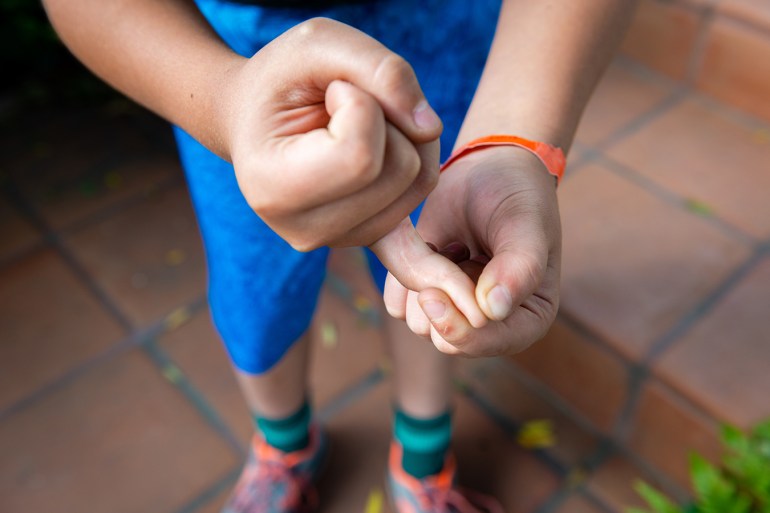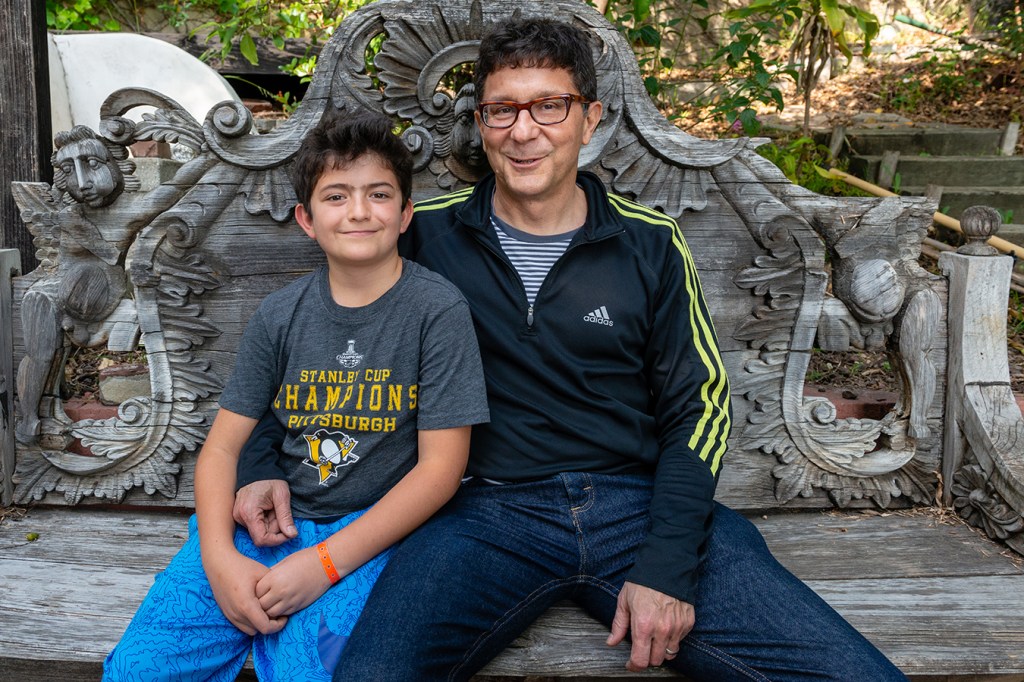Angel Dean Lopez is a Hollywood television writer and father who enjoys doing projects with his three kids. Every fall, he helps them transform 7-inch-long blocks of wood into whimsical race cars for the neighborhood’s annual Pinewood Derby in the Los Feliz area of Los Angeles.
“So you have to take your block of wood, shape it, sand it, paint it, use your imagination,” Lopez said, pointing to some favorites from derbies past that sit on a shelf in his home office — cars in the shape of an ice cream cone, a penguin and an Altoids peppermint box.
But one derby project lives in infamy: an S. Pellegrino bottle on wheels. It was the brainchild of his son Theo, then 9, in the fall of 2016, a time when Lopez recalls he was frantically busy at work.
“I was in a hurry and I did a horrible thing,” he said, recalling how his hand slipped as he was using a handheld power tool called a router with a fast-spinning, blade that shaves and shapes wood. He had flipped the machine over to try to save time. Improvising was a bad idea.
After surgery and a two-day hospital stay, Lopez returned home with his pinkie finger sewn together at an odd angle and his right hand immobilized in a cast.
Then, about a week later, it was déjà vu — Theo seriously injured his hand carving a Halloween pumpkin.
“My knife got stuck and my fingers slipped down the blade,” Theo recalled. He cut down to the tendon of his pinkie finger and required a complex surgical repair. Surprisingly, he said it didn’t hurt.
Following their surgeries, doctors ordered father and son to undertake numerous rounds of occupational therapy to help them regain full use of their hands.

Theo Lopez, 11, seriously injured his right hand and fingers while carving Halloween pumpkins at age 9. (Heidi de Marco/California Healthline)

Angel Dean Lopez holds the power tool that sliced his finger. (Heidi de Marco/California Healthline)
For Theo, therapy lasted about a year. For Lopez, it was several months and then repeated after follow-up surgery. The healing went well for both, and Lopez was pleased. Lopez has insurance through the Writers Guild of America, and has always been happy with its low premiums and deductibles. He wasn’t worried about coverage for this specialized occupational therapy that both father and son clearly needed.
And then the bills came.
Patients: Angel Dean Lopez, a television writer, Los Angeles. Theo Lopez, 11, student, Los Angeles.
Total bill: $10,190 for occupational therapy for two patients, father and son. Of that total, the Lopez family paid $8,561 — $4,836 for son Theo and $3,725 for dad Angel.
Service providers: Children’s Hospital Los Angeles for Theo Lopez; Cedars-Sinai Medical Center Hand Therapy Clinic for Angel Dean Lopez.
Medical procedures: Angel had reconstructive plastic surgery on three fingers as well as a second surgery to remove a pin stabilizing his fourth finger; he was in a cast for two months. Theo also had reconstructive plastic surgery to repair his tendon.
After such injuries, patients typically need sessions of occupational therapy where specialists use techniques such as massage, strengthening and stretching exercises to regain normal function and movement. Both father and son needed custom splints made and tweaked by the therapists throughout the healing.
Lopez said if it weren’t for the odd coincidence of two family members requiring the same medical care at the same time, he may have let all this slide. But the financial double whammy has left him facing thousands in out-of-pocket costs that he wasn’t expecting.
What Gives: Lopez’s Writers Guild of America insurance covers and paid $60 for each occupational therapy visit. The providers charge a list price of over $500 per session, an amount that was reduced to about $325 when billed to the insurer because of its negotiated discounts.
The proper rate for occupational (and physical) therapy is a bone of contention between insurers and therapists. And the Lopez family is caught in the middle, in need of treatments to regain full use of their hands so Angel can again type his television scripts and Theo can again play bluegrass music on his fiddle.
The union’s payment of a flat fee of $60 “is lower than any private insurer we’ve seen,” said Randall Steward, vice president of enterprise contracting and payor relations at Children’s Hospital Los Angeles. But rates insurers pay for occupational or physical therapy are highly variable.
Medicare would pay $124 per 45-minute session for occupational therapy — more than double what Lopez’s insurer paid. Healthcare Bluebook, a company that analyzes claims data for consumers and hospitals, pegs the fair range in Los Angeles between $204 and $252 per 45-minute session.
The Writers Guild declined to comment for this article, but one reason its rate is so low is that it classifies occupational and physical therapy not as ancillary medical services but as alternative treatment, on par with acupuncture and chiropractic care, according to insurance policy documents provided by Lopez.
“This is not typical. I’ve worked for payors and hospitals now for close to 25 years,” Steward said. “I’ve never seen an insurance plan categorize occupational and physical therapy, as this plan does, as an alternative treatment.”
Also, because of that categorization in Lopez’s plan, the amount not covered by insurance that Lopez has to pay out-of-pocket does not even count toward the family’s “out-of-pocket maximum” — that’s when the sum of deductibles, premiums and other charges reaches a threshold that triggers the insurer to pick up the remainder of the tab.
Sharmila Sandhu, who is counsel and director of regulatory affairs for the American Occupational Therapy Association, said that insurers are using various techniques to limit payouts, leaving patients on the hook for bigger bills. “We are finding that insurance companies are increasing the copayment amounts for occupational therapy services or identifying other ways to limit the frequency or duration of visits a client can access,” Sandhu said.
The Resolution: Lopez appealed the decision in a four-page letter to the Writers Guild of America claims department. The Writers Guild health policy denied the appeal. Lopez said a representative for the union told him it would be reviewing its reimbursement policy for occupational therapy.
The Takeaway: Remember that occupational and physical therapy rates vary considerably and health insurers vary greatly in their coverage. Out-of-pocket payments can really add up since almost all patients need a number of sessions.
Ask questions about how your insurance will cover those services as they are prescribed by your doctor. If you feel it is inadequate, negotiate with both the insurer and the provider. If the costs are unaffordable, ask your prescribing doctor if a more limited course of therapy would do the trick.
This story was produced by Kaiser Health News, an editorially independent program of the Kaiser Family Foundation.
[Clarification: This story was updated at 12 p.m. PT to clarify that not all of the Lopezes’ occupational therapy sessions lasted 45 minutes. Some were an hour long.]


